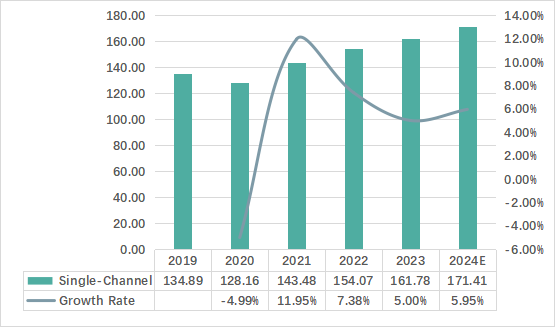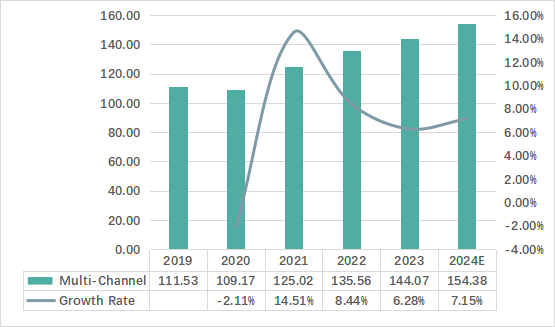1. Different Types of Fiber Optic Rotary Joints
FORJs can be single- or multi-channel, depending on the number of fiber optic cables that need to be transferred.
Single-channel FORJ
The single-channel FORJ has a simple mechanical structure that allows the device to be compact, high-speed, highly reliable, and long-lasting. A single-mode fiber can carry tens if not hundreds of channels of electronic data channels.
Multi-Channel FORJ
A much more complex mechanical structure is necessary to facilitate the multi-pass (multi-channel) FORJs. The device also requires careful optical alignment to maintain good performance in all three key areas mentioned above.
2. Global Fiber Optic Rotary Joints Value (M USD) by Type (2019-2024)
| 2019 | 2020 | 2021 | 2022 | 2023 | 2024E |
Single-Channel | 134.89 | 128.16 | 143.48 | 154.07 | 161.78 | 171.41 |
Multi-Channel | 111.53 | 109.17 | 125.02 | 135.56 | 144.07 | 154.38 |
Total | 246.42 | 237.33 | 268.49 | 289.64 | 305.85 | 325.78 |
The table detailing the market value of Fiber Optic Rotary Joints (FORJ) by type from 2019 to 2024 showcases a significant growth trajectory. The Single-Channel FORJs achieved a market value of $134.89 million in 2019 and experienced a steady increase to reach $171.41 million by 2024, this suggests a strong market presence and potential for this type of FORJ. The Multi-Channel FORJs held a market value of $111.53 million in 2019 and is expected to reach $154.38 million by 2024.
Global Fiber Optic Rotary Joints Value (M USD) and Growth Rate of Single-Channel

Global Fiber Optic Rotary Joints Value (M USD) and Growth Rate of Multi-Channel

3. Global Fiber Optic Rotary Joints Value Share by Type (2019-2024)
| 2019 | 2020 | 2021 | 2022 | 2023 | 2024E |
Single-Channel | 54.74% | 54.00% | 53.44% | 53.19% | 52.89% | 52.61% |
Multi-Channel | 45.26% | 46.00% | 46.56% | 46.81% | 47.11% | 47.39% |
Total | 100.00% | 100.00% | 100.00% | 100.00% | 100.00% | 100.00% |
The market value share analysis reveals the proportion of the total market value that each FORJ type contributes. In 2019, Single-Channel FORJs accounted for 54.74% of the total market value, while Multi-Channel FORJs held a substantial 45.26%. By 2024, the share of Single-Channel FORJs increased to 52.61%, whereas Multi-Channel FORJs captured approximately 47.39% of the market value share.
4. Global Fiber Optic Rotary Joints Production (K Units) by Type (2019-2024)
| 2019 | 2020 | 2021 | 2022 | 2023 | 2024E |
Single-Channel | 177.68 | 171.80 | 187.47 | 198.50 | 208.72 | 220.89 |
Multi-Channel | 18.98 | 18.68 | 20.66 | 22.01 | 23.30 | 24.83 |
Total | 196.65 | 190.48 | 208.13 | 220.51 | 232.03 | 245.71 |
Production volume data provides insights into the supply side of the market. Single-Channel FORJs saw a steady increase in production, starting from 177,680 units in 2019 and reaching 220,890 units by 2024. This indicates a consistent growth in supply to meet the market’s demands.
5. Global Fiber Optic Rotary Joints Production Share by Type (2019-2024)
| 2019 | 2020 | 2021 | 2022 | 2023 | 2024E |
Single-Channel | 90.35% | 90.19% | 90.07% | 90.02% | 89.96% | 89.90% |
Multi-Channel | 9.65% | 9.81% | 9.93% | 9.98% | 10.04% | 10.10% |
Total | 100.00% | 100.00% | 100.00% | 100.00% | 100.00% | 100.00% |
The single-channel segment dominated the Fiber Optic Rotary Joints market from 2019 to 2024. In 2019, Multi-Channel FORJs constituted 9.65% of the total production, while Single-Channel FORJs accounted for 90.35%. By 2024, the production share of Multi-Channel FORJs slightly increased to 10.10%, and Multi-Channel FORJs maintained a share of 89.90%. Despite the smaller production shares, Multi-Channel FORJs have shown stability in their production, with minor fluctuations. This data further emphasizes the market’s trend towards Single-channel technology.
6. Global Fiber Optic Rotary Joints Price (USD/Unit) by Type (2019-2024)

This section focuses on the price analysis of Fiber Optic Rotary Joints (FORJ) by type from 2019 to 2024.
In 2019, the average price per unit for Single-Channel FORJs was $759. This price remained relatively stable over the years, with slight fluctuations, and is projected to be around $776 by 2024. The stability in price suggests a mature market segment with consistent demand and supply dynamics. In 2019, the average price per unit for Multi-Channel FORJs started at a higher point of $5,877 and is expected to reach $6,218 in 2024, due to the complexity and advanced technology involved in their production.
The price trend reveals that while Single-Channel FORJs maintain a stable price trajectory, Multi-Channel FORJs experience more dynamic pricing, reflecting the impact of technological advancements and market competition. This information is crucial for stakeholders to understand the cost implications of their business strategies and to anticipate how market dynamics may affect their pricing decisions. The projected prices for 2024 provide a basis for forecasting and strategic planning in the FORJ industry.





